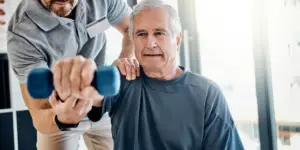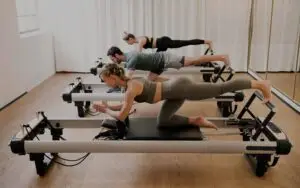Did you know? You reach your muscle peak at about age 25-30? It’s true! And after that you reach a general and steady decline. And that’s actually the same for bone mass. So, I want you to keep that in mind when thinking about your knee OA. I don’t mean it in a ‘doom and gloom’ way but it’s just the way we are as humans. It’s like wrinkles of the face – obviously everyone wants to stay in their 20-year-old skin, but that’s just life. There’s nothing wrong with wrinkles. So, I like to refer to knee OA as wrinkles of the joints. There’s nothing wrong with them, but we just have to manage it in a way to prevent it from being a problem that stops us from doing what we love.
Let’s talk research! A research paper was done last year (2019) with patients that had no knee pain WHATSOEVER! Read that again! So in this study, 5,397 knees were scanned! That’s a lot of knees! What they found was that up to 43% of people in their 40’s had arthritis, but wait! We said initially that these people had NO KNEE PAIN, WHATSOEVER! So, what does that tell us, you ask? Well, it shoes that arthritis is not proportional to pain! And that pain does not equal damage! The degree of arthritis isn’t relative to how much knee pain you have! Some people that have ‘really bad’ arthritis may not actually have severe pain! And vice versa!
So that’s the first thing – pain does not equal damage & arthritis is like wrinkles which doesn’t have to be painful.
I’m going to paint this picture for you, and you can tweak it to suite you but it’s almost always right. Person X is an avid runner! Goes running 3x per week, but as he gets older, he feels some niggling pain in the knee. He persists with the running, choosing not to believe that he has pain. Which then progressively worsens over time. Person X goes to the GP and the GP orders X-rays and the results say, “knee OA.” Head down, he eventually parks the whole running idea to the side.
As Person X ages, the pain worsens but he’s not even doing running. The pain arises with general activities – going up and down stairs, stiffness in the mornings for the first 5 minutes and he’s always hobbling around. “The OA is getting worse,” he thinks to himself! He pays a visit to a surgeon and he says, “you’re too young for a knee replacement, so you’ll just have to wait.”
Could this have been avoided? Of course!
First things first, strengthening is necessary. Mandatory. Essential. Whatever, you may think about strength training, you must do it. It’s important for all ages! The earlier you can get started with strengthening exercises, the better off you are. It doesn’t have to be in a gym with all these meat heads. We, as physios, can give you very simple exercises which can be done at home or in a park. We can modify them to suit you and your needs! Or we can refer you on to the appropriate yoga or Taiichi exercise classes.
The stronger the muscles are, the less amount of force being placed within the joints. When you have a reduced amount of force placed within the joints, you have reduced the impact placed through the joint and therefore reduce the pain. At Agape Physio, we can prescribe specific tailored exercises to reduce the load placed through the joints.
Just a quick story I like to share with my patients that have knee OA! My mum isn’t a very active person. She’s busy with work and life in general. She goes from the house, to the car, to work and then back again. Her work is even a desk job. You could safely say at least 70% of her day is sitting down. She’s had moderate-severe OA in her knees for the last 10 years. But whenever we go overseas, we are walking for the majority of the day. So, for the first week, she mentions her knee pain; however, for the remaining weeks she never mentions her knee pain. I noticed it, so i asked her and she said she’s oddly doesn’t feel her usual knee pain. The first 2-3 weeks of being back at home, she also has little to no pain. But then the pain gradually increases. What changed from the time we were overseas to being here in Australia?
The only difference was that she was walking a lot more than what she usually does in her everyday life. Don’t underestimate exercises as simple as walking, it really does help!
With those that have OA, walking can be difficult due to the pain, which then leaves you walking around with a slight limp. A simple change that I prescribe is to reduce the amount of contact time your legs have with the ground, by increasing the number of steps you take in the same amount of time/distance. So, for example, instead of taking 20 steps in 1 minute take 25-30 steps in that same minute. You’re not walking faster; you’re just walking with shorter steps – that’s all. But it makes a massive difference with your walking and pain. It actually reduces the amount of force through your knees as well as the duration of that force being placed through your knees.
Something that is heavily dismissed is diet! What foods you eat actually effects your body in so many different ways. As much as possible, try and avoid sugars and processed foods as this increases the amount of inflammation that can occur in your joints. Control, but don’t get rid of, the amount of carbs you take as well.
Just as your diet can increase inflammation, your diet can also reduce the inflammation. Foods like turmeric, blueberries and curcumin are all anti-inflammatory goods (have a read of our Facebook and Instagram post about nutrition and its effects for some more information).
Losing weight significantly helps with a couple of things that contribute to your knee OA – it reduces the load placed through your joints, reducing body fat also reduces inflammation as well as reduces pain sensitivity. You want some stats? Well, those that have knee OA and are overweight, for every 10% loss of weight, symptoms and function improve by 50%! 10% is all it takes! Another stat, you ask? Well for every kilo of weight lost, it leads to a 4kg reduction of pressure on the knee joints! So if you lose 2kg, you’re reducing 8kg of force on your knees! Crazy huh!
Movement as a whole is very important in our everyday lives – across all ages. Movement and exercise helps bring fresh joint fluid into our joints which helps with health and healing of our bones, cartilage and joints. But there’s a fine line between too much movement and too little movement. Too much can result in you being in pain for days after and too little movement results in muscle wastage, stiffness and results in worsening knee pain. The bottom line is that you want to encourage rather than force. Encourage exercise and movement rather than force the exercises and movement.
I hope this little blog helped clear up some questions and directs you to a healthier and more fulfilling life! If you have any questions or queries, we would love to help you at Agape Physiotherapy.
Stay active, stay healthy and most importantly, stay happy.





